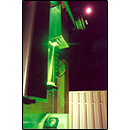Design of a Safety Radar System to Enable Safe Off Zenith Laser Transmission
Document ID: 17
Master's Thesis
The Pennsylvania State University
The Graduate School
Department of Electrical Engineering
Abstract
Powerful lasers are required in lidar experiments to obtain backscatter returns from various constituents in the atmosphere. Most lidar experiments take place in unrestricted airspace where aircraft could easily pass through the beam. The concern is for eye safety of the people on the plane who could look directly into the beam or those who may view a dangerous specular reflection off of an aircraft. Spotters are currently used in most lidar systems to watch for aircraft and shut off the laser if one approaches the beam. The spotter, however, cannot see through clouds to protect an aircraft from a laser that can scan down to a 30° elevation angle. In addition, the safety spotter must watch a larger portion of the sky in order to protect aircraft from the scanning beam.
A modified marine radar is presented as a primary safety system to help the spotter. A safety radar system is more reliable and is able to track with the movements of the WAVE-LARS scanning lidar system. The laser beam will be surrounded by the wide beam pattern of the radar. Through automated sensing circuitry, the radar can shut the laser off when aircraft approach the beam.
The marine radar is described along with the modifications made to it. The new safety radar system contains an improved transceiver housing, antenna, and a rack mounted electronics chassis which controls the safety radar from inside a mobile laboratory. Return signal plots are presented with analysis on why the system will be able to detect aircraft. Areas of future work are also proposed.
Keywords: safety radar, lidar, laser safety
| Citation: | J. Yurak, "Design of a Safety Radar System to Enable Safe Off Zenith Laser Transmission", The Pennsylvania State University, Master's Thesis, December 1994, 84 pages |
Images
 | LARS - 4 |
